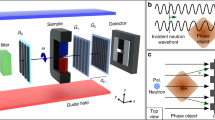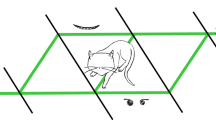Abstract
Particle physicists see neutrons as tiny massive particles with a confinement radius of about 0.7 fm and a distinct internal quark–gluon structure. In quantum mechanics, neutrons are described by wave packets whose spatial extent may become ten orders of magnitude larger than the confinement radius, and can even reach macroscopic dimensions, depending on the degree of monochromaticity. For neutrons passing through narrow slits, it has been predicted1,2 that quantization of the transverse momentum component changes the longitudinal momentum component, resulting in a phase shift that should be measurable using interferometric methods3. Here we use neutron interferometry to measure the phase shift arising from lateral confinement of a neutron beam passing through a narrow slit system. The phase shift arises mainly from neutrons whose classical trajectories do not touch the walls of the slits. In this respect, the non-locality of quantum physics is apparent.
This is a preview of subscription content, access via your institution
Access options
Subscribe to this journal
Receive 51 print issues and online access
$199.00 per year
only $3.90 per issue
Buy this article
- Purchase on Springer Link
- Instant access to full article PDF
Prices may be subject to local taxes which are calculated during checkout




Similar content being viewed by others
References
Lévy-Leblond, J. M. A geometrical quantum phase effect. Phys. Lett. A 125, 441–442 (1987)
Greenberger, D. M. A new non-local effect in quantum mechanics. Physica B 151, 374–377 (1988)
Rauch, H. & Werner, S. A. Neutron Interferometry (Clarendon, Oxford, 2000)
Casimir, H. B. G. & Polder, D. Influence of retardation on the London-van der Waals forces. Phys. Rev. 73, 360–372 (1948)
Haroche, S. & Raimond, J. M. Cavity quantum electrodynamics. Sci. Am. 268, 26–33 (1993)
Fonda, L., Ghirardi, G. C., Rimini, A. & Weber, T. On the quantum foundations of the experimental decay law. Nuovo Cimento A 15, 689–704 (1973)
Misra, B. & Sudarshan, E. C. G. The Zeno's paradox in quantum theory. J. Math. Phys. 18, 756–763 (1977)
Grisenti, R. E. et al. Determination of atom-surface van der Waals potentials from transmission diffraction intensities. Phys. Rev. Lett. 83, 1755–1758 (1999)
Hegerfeldt, G. C. & Koehler, T. Deviations from classical optics in matter diffraction and determination of the size of weakly bound molecules. Phys. Rev. A 61, 023606-1–023606-10 (2000)
Ferry, D. K., Grubin, H., Jacobini, C. & Jauho, A. J. (eds) Quantum Transport in Ultrasmall Devices (Plenum, New York, 1995)
Salomon, C., Dalibard, J., Aspect, A., Metcalf, H. & Cohen-Tannoudji, C. Channeling atoms in a laser standing wave. Phys. Rev. Lett. 59, 1659–1662 (1987)
Keller, C. et al. Adiabatic following in standing-wave diffraction of atoms. Appl. Phys. B 69, 303–309 (1999)
Allman, B. E., Cimmino, A., Griffin, S. L. & Klein, A. G. Quantum phase shift caused by spatial confinement. Found. Phys. 29, 325–332 (1999)
Nesvizhevsky, V. V. et al. Quantum states of neutrons in the Earth's gravitational field. Nature 415, 297–299 (2002)
Flügge, S. Practical Quantum Mechanics (Springer, Berlin, 1971)
Pokotilovski & Yu, N. Quantum phase shift of spatially confined de Broglie waves in a gravitational field. Phys. Lett. A 248, 114–116 (1998)
Rauch, H., Wölwitsch, H., Kaiser, H., Clothier, R. & Werner, S. A. Measurement and characterization of the three-dimensional coherence function in neutron interferometry. Phys. Rev. A 53, 902–908 (1996)
Rauch, H. & Summhammer, J. Neutron interferometer absorption experiments in the quantum limit. Phys. Rev. A 46, 7284–7287 (1992)
Acknowledgements
This work was supported by the Austrian Science Foundation and a TMR-Network of the European Union EU. Useful discussions with J. Summhammer and D. Petrascheck are gratefully acknowledged.
Author information
Authors and Affiliations
Corresponding author
Ethics declarations
Competing interests
The authors declare that they have no competing financial interests.
Rights and permissions
About this article
Cite this article
Rauch, H., Lemmel, H., Baron, M. et al. Measurement of a confinement induced neutron phase. Nature 417, 630–632 (2002). https://doi.org/10.1038/nature00773
Received:
Accepted:
Issue Date:
DOI: https://doi.org/10.1038/nature00773
This article is cited by
-
Tests of fundamental quantum mechanics and dark interactions with low-energy neutrons
Nature Reviews Physics (2021)
-
Observation of a quantum Cheshire Cat in a matter-wave interferometer experiment
Nature Communications (2014)
-
Gravitational states of antihydrogen near material surface
Hyperfine Interactions (2012)
-
Neutrons in a whispering gallery
Nature Physics (2010)
Comments
By submitting a comment you agree to abide by our Terms and Community Guidelines. If you find something abusive or that does not comply with our terms or guidelines please flag it as inappropriate.



